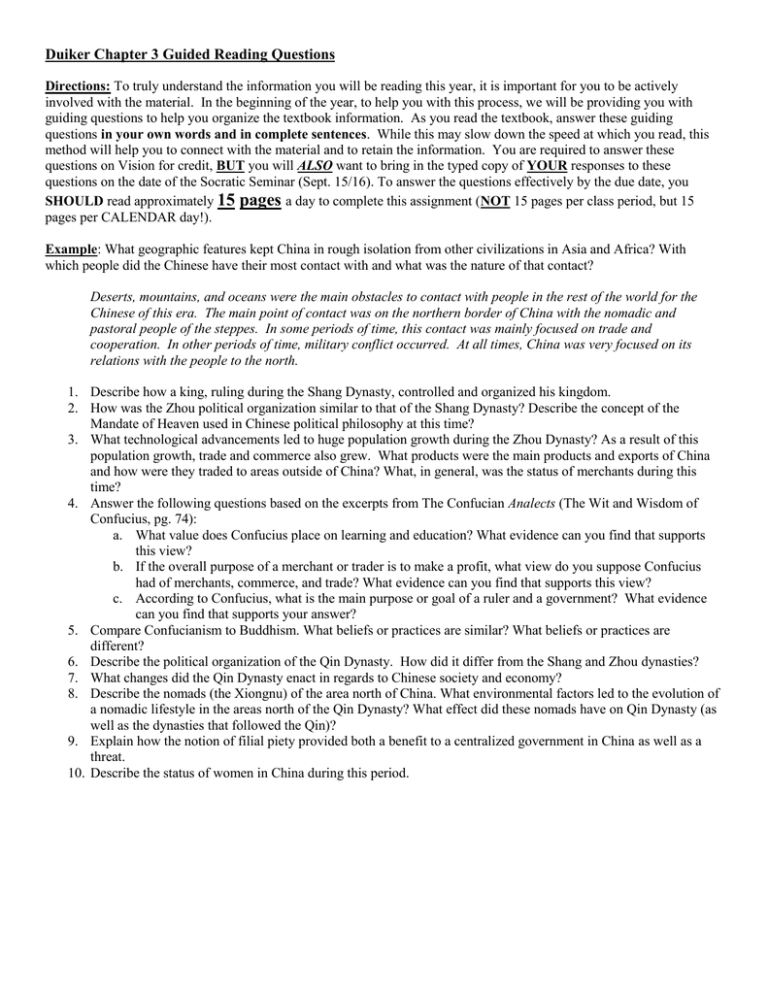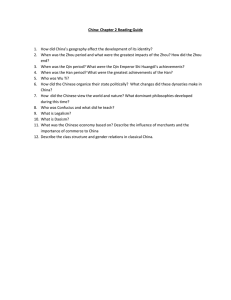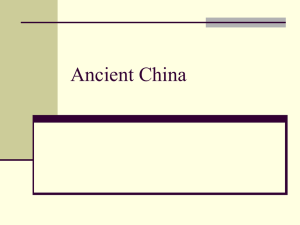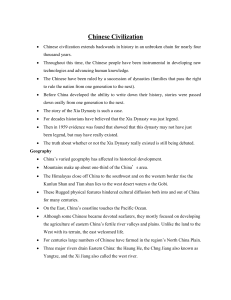Duiker Chapter 3 Guided Reading Questions
advertisement

Duiker Chapter 3 Guided Reading Questions Directions: To truly understand the information you will be reading this year, it is important for you to be actively involved with the material. In the beginning of the year, to help you with this process, we will be providing you with guiding questions to help you organize the textbook information. As you read the textbook, answer these guiding questions in your own words and in complete sentences. While this may slow down the speed at which you read, this method will help you to connect with the material and to retain the information. You are required to answer these questions on Vision for credit, BUT you will ALSO want to bring in the typed copy of YOUR responses to these questions on the date of the Socratic Seminar (Sept. 15/16). To answer the questions effectively by the due date, you SHOULD read approximately 15 pages a day to complete this assignment (NOT 15 pages per class period, but 15 pages per CALENDAR day!). Example: What geographic features kept China in rough isolation from other civilizations in Asia and Africa? With which people did the Chinese have their most contact with and what was the nature of that contact? Deserts, mountains, and oceans were the main obstacles to contact with people in the rest of the world for the Chinese of this era. The main point of contact was on the northern border of China with the nomadic and pastoral people of the steppes. In some periods of time, this contact was mainly focused on trade and cooperation. In other periods of time, military conflict occurred. At all times, China was very focused on its relations with the people to the north. 1. Describe how a king, ruling during the Shang Dynasty, controlled and organized his kingdom. 2. How was the Zhou political organization similar to that of the Shang Dynasty? Describe the concept of the Mandate of Heaven used in Chinese political philosophy at this time? 3. What technological advancements led to huge population growth during the Zhou Dynasty? As a result of this population growth, trade and commerce also grew. What products were the main products and exports of China and how were they traded to areas outside of China? What, in general, was the status of merchants during this time? 4. Answer the following questions based on the excerpts from The Confucian Analects (The Wit and Wisdom of Confucius, pg. 74): a. What value does Confucius place on learning and education? What evidence can you find that supports this view? b. If the overall purpose of a merchant or trader is to make a profit, what view do you suppose Confucius had of merchants, commerce, and trade? What evidence can you find that supports this view? c. According to Confucius, what is the main purpose or goal of a ruler and a government? What evidence can you find that supports your answer? 5. Compare Confucianism to Buddhism. What beliefs or practices are similar? What beliefs or practices are different? 6. Describe the political organization of the Qin Dynasty. How did it differ from the Shang and Zhou dynasties? 7. What changes did the Qin Dynasty enact in regards to Chinese society and economy? 8. Describe the nomads (the Xiongnu) of the area north of China. What environmental factors led to the evolution of a nomadic lifestyle in the areas north of the Qin Dynasty? What effect did these nomads have on Qin Dynasty (as well as the dynasties that followed the Qin)? 9. Explain how the notion of filial piety provided both a benefit to a centralized government in China as well as a threat. 10. Describe the status of women in China during this period.





